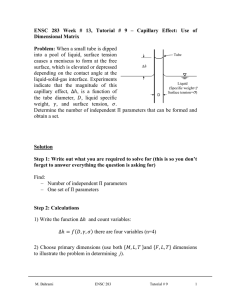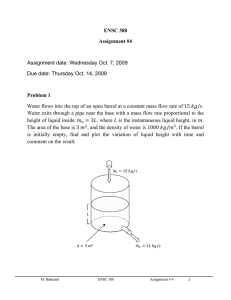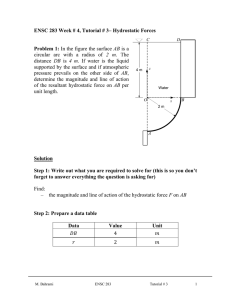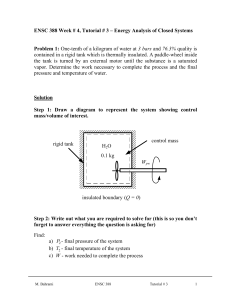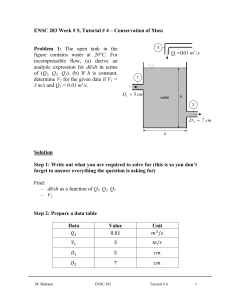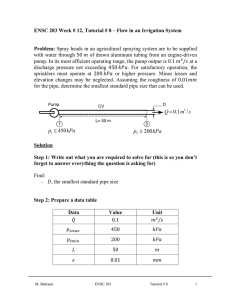ENSC 388 Week # 7, Tutorial #6 – Entropy Problem 1: 400°C,
advertisement
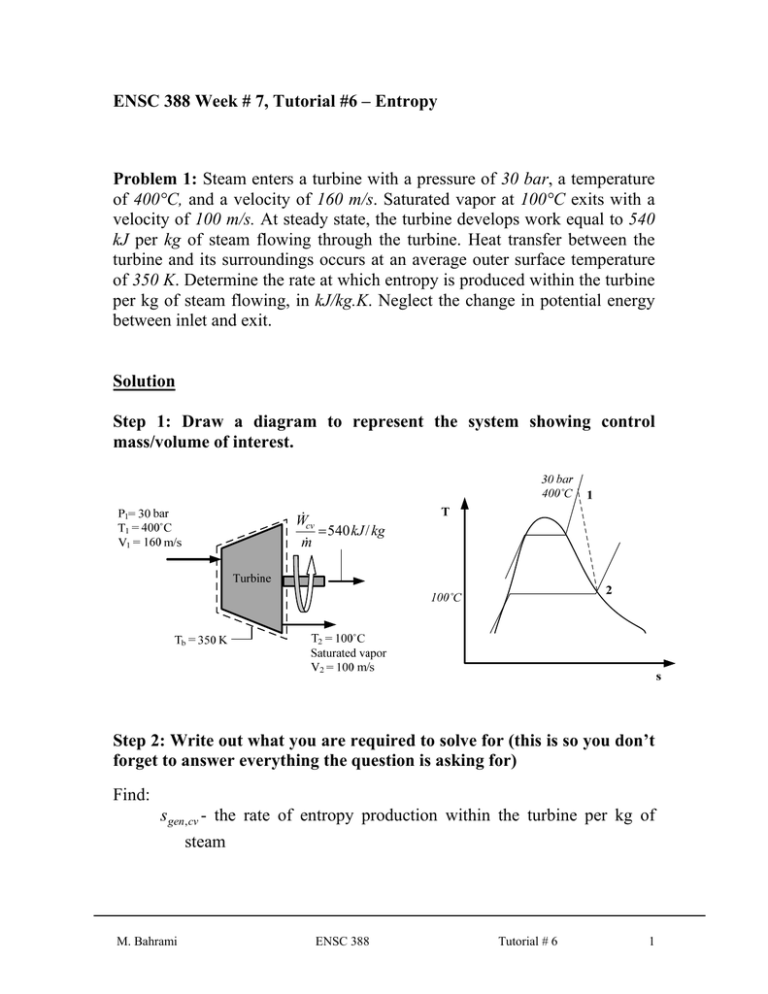
ENSC 388 Week # 7, Tutorial #6 – Entropy Problem 1: Steam enters a turbine with a pressure of 30 bar, a temperature of 400°C, and a velocity of 160 m/s. Saturated vapor at 100°C exits with a velocity of 100 m/s. At steady state, the turbine develops work equal to 540 kJ per kg of steam flowing through the turbine. Heat transfer between the turbine and its surroundings occurs at an average outer surface temperature of 350 K. Determine the rate at which entropy is produced within the turbine per kg of steam flowing, in kJ/kg.K. Neglect the change in potential energy between inlet and exit. Solution Step 1: Draw a diagram to represent the system showing control mass/volume of interest. Wcv 540 kJ / kg m Step 2: Write out what you are required to solve for (this is so you don’t forget to answer everything the question is asking for) Find: s gen, cv - the rate of entropy production within the turbine per kg of steam M. Bahrami ENSC 388 Tutorial # 6 1 Step 2: Prepare a data table Data Value Unit T1 400 [ C ] P1 V1 T2 V2 30 160 100 100 540 [bar] [m / s] Wcv / m [ C ] [m / s] [kJ / kg ] Step 3: State your assumptions (you may have to add to your list of assumptions as you proceed in the problem) Assumptions: 1) The control volume shown on the accompanying sketch is at steady state. 2) Heat transfer from the turbine to the surrounding occurs at a specified average outer surface temperature. 3) The change in potential energy between inlet and exit can be neglected. Step 4: Calculations To determine the entropy production per unit mass flowing through the turbine, begin with mass and entropy rate balances for the one-inlet, one-exit control volume at steady state: 0 j M. Bahrami Q j Tj 0 m 1 m 2 (Eq1) m 1s1 m 2 s2 S gen, cv (Eq2) ENSC 388 Tutorial # 6 2 Since heat transfer occurs only at Tb = 350 K, the first term on the right side of the entropy rate balance reduces to Q cv / Tb . Combining the mass and entropy rate balances 0 Q cv m ( s1 s2 ) S gen, cv Tb (Eq3) where m is the mass flow rate. Solving for Sgen,cv / m s gen, cv S gen, cv Q / m cv ( s2 s1 ) m Tb (Eq4) The heat transfer rate, Q cv / m , required by this expression is evaluated next. Reduction of the mass and energy rate balances results in V22 V12 Q cv Wcv ( h2 h1 ) m m 2 (Eq5) where the potential energy change from inlet to exit is dropped by assumption 3. From Table A-6 at 30 bar, 400°C, h1 3231.7 kJ / kg , and from Table A-4, h2 hg (100 C ) 2675.6 kJ / kg . Thus 2 kJ kJ (100) 2 (160) 2 m Q cv 540 (2675.6 3231.7) m 2 kg kg s (Eq6) 1 N 1 kJ 540 556.1 7.8 23.9 kJ / kg 2 1000 N . m 1 kg . m / s From Table A-4, s2 s g (100 C ) 7.3542 kJ / kg.K , and from Table A-6, s1 6.9235 kJ / kg.K . Inserting values into the expression for entropy production, Eq4, s gen, cv kJ (23.9 kJ / kg.K ) (7.3542 6.9235) 350 K kg.K (Eq7) 0.0683 0.4307 0.499 kJ/kg.K M. Bahrami ENSC 388 Tutorial # 6 3 If the boundary were located to include a portion of the immediate surroundings so heat transfer would take place at the temperature of the surroundings, Tf = 293 K, the entropy production for the enlarged control volume would be 0.511 kJ/kg.K. Problem 2 An insulated piston-cylinder device initially contains 0.02 of saturated liquid-vapour mixture of water with a quality of 0.1 at 100 . Now some ice at 18 is dropped into the cylinder. If the cylinder contains saturated liquid at 100 when thermal equilibrium is established, determine (a) the amount of ice added and (b) the entropy generation during this process. The melting temperature and the heat of fusion of ice at atmospheric pressure are 0 and 333.7 / . 18 0.02 100 Solution Known: Find: - The amount of ice added to the water. - The entropy generation. Assumptions: - Thermal properties of the ice are constant. - The cylinder is well-insulated and thus heat transfer is negligible. - There is no stirring by hand or a mechanical device (it will add energy). M. Bahrami ENSC 388 Tutorial # 6 4 Analysis: (a) We take the contents of the cylinder (ice and saturated water) as our system, which is a closed system. Noting that the temperature and thus the pressure remains constant during this phase change process and thus ∆ ∆ , the energy balance for this system can be written as: ∆ , ∆ ∆ ∆ , ∆ 0 . 0 or 0 0 0 The specific heat of ice at about 0 is 2.11 / ° (Table A-3). The melting temperature and the heat of fusion of ice at 1 are 0 and 333.7 / . The properties of water at 100 are (Table A-4): 0.001043 , 419.17 1.6720 , 1.3072 2256.4 , . 0.001043 6.0490 0.1 1.6720 . 0.001043 0.16814 419.17 0.1 1.3072 1.9119 M. Bahrami . 2256.4 0.1 644.81 6.0470 . . ENSC 388 Tutorial # 6 5 419.17 @ 1.3072 @ . 0.2 0.119 0.16814 Noting that 18 , 2.11 100 and 0 . 4.18 and substituting gives: 18 100 . 0.119 333.7 0 644.81 419.17 0 m 0.034 kg 34 g ice (b) We take the ice and the steam as our system, which is a closed system. Considering that the tank is well-insulated and thus there is no heat transfer, the entropy balance for this closed system can be expressed as: ∆ 0 ∆ ∆ 0.119 ∆ 1.3072 1.9119 . . 0.0719 ∆ ∆ ∆ ∆ ∆ 0.034 2.11 0.034 ∆ M. Bahrami 273.15 255.15 . 333.7 273.15 ENSC 388 0.0049 0.0415 Tutorial # 6 6 ∆ 0.034 4.18 373.15 273.15 . 0.0443 ∆ 0.0049 0.0415 0.0443 0.0907 Then, 0.0907 M. Bahrami ENSC 388 0.0719 0.0188 Tutorial # 6 7
